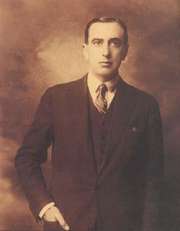|
Biografie Vicente Huidobro
Vicente García-Huidobro Fernández (January 10, 1893 – January 2, 1948) was a Chilean poet born to an aristocratic family. He was an exponent of the artistic movement called Creacionismo ("Creationism"), which held that a poet should bring life to the things he or she writes about, rather than just describe them.
Huidobro was born into a wealthy family in Santiago. After spending his first years in Europe, he enrolled in a Jesuit secondary school in Santiago where he was expelled for using a ring, which he claimed, was for marriage. He studied literature at the University of Chile and published Ecos del alma (Soul's Echoes) in 1911, a work with modernist tendencies. The following year he married, and started to edit the journal Musa Joven (Young Muse), where part of his later book, Canciones en la noche (Songs in the Night) appeared, as well as his first calligram, "Triángulo armónico" ("Harmonic Triangle").
In 1913, along with Carlos Díaz Loyola, he edited the three issues of the journal Azul, and published both Canciones en la noche and La gruta del silencio (The Grotto of Silence). The next year, he gave a lecture, Non serviam, which reflected his aesthetic creed. In another work of the same year, he explained his religious doubts and criticized the Jesuits, earning himself the reproach of his family.
In 1916 he moved to Europe with his wife and children. While in Madrid, he met Rafael Cansinos-Asséns, with whom he had exchanged letters since 1914. He settled in Paris and published Adán (Adam), a work that began his next phase of artistic development. Huidobro met and mixed with most of the Parisian avant garde of this period: Pablo Picasso, Juan Gris, Jacques Lipchitz, Francis Picabia, Joan Miró, Max Ernst, Paul Éluard and Blaise Cendrars.
In October 1918 Huidobro traveled to Madrid, the first of a series of annual trips to that city. There he shared both Creacionismo and his knowledge of the Parisian vanguard with the artistic elite. Thus began the literary movement Ultraísmo. He corresponded with Tristan Tzara and collaborated with him on his Dadaist journal. The following year he brought a rough draft to Madrid of the series of poems that would eventually become his masterwork, Altazor.
While Huidobro continued to write in Paris, in 1921 he founded and edited the international journal of art, Creación in Madrid; the journal featured a Lipchitz sculpture and the paintings of Georges Braque, Picasso, Gris and Albert Gleizes. In November he printed the second issue in Paris and entitled it Création Revue d'Art. In December he presented his famous lecture, La Poesía (Poetry), which served as prologue to Temblor de Cielo (Tremor of Heaven).
He continued his multifarious artistic activities in Europe until 1925, when he moved back to Chile to edit and publish political journalism and criticism. Youthful supporters proclaimed him their candidate for president. A bomb explosion followed in front of his house, however Huidobro escaped unharmed.
He returned to Europe by the late 1920s, where he began to write the novel, Mío Cid Campeador; he also continued his work on Altazor and began Temblor de Cielo. It was at this time that he discovered that he was heir to the marquisate of Casa Real. He also participated to the Mandrágora Surrealist movement founded in 1938.
The poet is survived by various family members including his daughter Raquel Huidobro, and grandchildren including Raimundo Rubio Huidobro, an accomplished contemporary painter and artist now living in NY.
|





